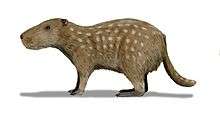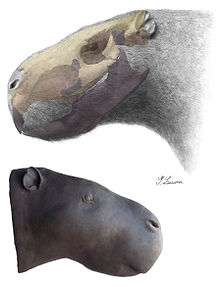Josephoartigasia monesi
| Josephoartigasia monesi Temporal range: Pliocene to Early Pleistocene 4–2 Ma | |
|---|---|
 | |
| Life restoration of J. monesi | |
| Scientific classification | |
| Kingdom: | Animalia |
| Phylum: | Chordata |
| Class: | Mammalia |
| Order: | Rodentia |
| Family: | Dinomyidae |
| Genus: | †Josephoartigasia |
| Species: | †J. monesi Rinderknecht & Blanco 2008 |
| Binomial name | |
| Josephoartigasia monesi Rinderknecht & Blanco 2008 | |
Josephoartigasia monesi, an extinct species of South American caviomorph rodent, is the largest rodent known, and lived from about 4 to 2 million years ago during the Pliocene to early Pleistocene.[1][notes 1] The species is one of two in the Josephoartigasia genus, the other being J. magna.[1] J. monesi is sometimes called the giant pacarana, after its closest living relative, the pacarana (Dinomys branickii) in the family Dinomyidae.[1] The species may have weighed a ton, considerably larger than its closest living relative, the pacarana.[1]
Description

The skull of the holotype is 53 cm (21 in) long, and the remaining incisor is more than 30 cm (12 in) in length. The total estimated body length is 3 m (10 ft), with a height of 1.5 m (5 ft).
Body mass
J. monesi replaced Phoberomys pattersoni, a related and somewhat older species that lived in Venezuela during the Late Miocene, as the largest rodent. However, size comparisons are difficult because previous estimates of 400 and 700 kg (880 and 1,540 lb) for P. pattersoni were based on fore and hind limb elements, which are not present in the J. monesi specimen.[1]
By comparing the skull with various extant species of rodents, the authors of the original paper estimated a mass between 468 and 2,586 kg (1,032 and 5,701 lb), with a median estimate of 1,211 kg (2,670 lb).[1] A later researcher revisited the numbers and came up with a more conservative estimate of 350 to 1,534 kg (772 to 3,382 lb), with a median of 900 kg (2,000 lb).[2]
Discovery and Etymology
J. monesi is known from an almost complete skull, which was recovered from the San José Formation on the coast of Río de la Plata in Uruguay.[1] Discovered in 1987, but not scientifically described until 2008, the specimen is preserved in Uruguay's National History and Anthropology Museum.[3] Josephoartigasia monesi was named after the paleontologist Álvaro Mones, for his study on the rodent in 1966.[1]
Paleobiology
The rodent's fearsome front teeth and large size may have been used to fight over females for breeding rights and may also have helped defend against predators, including carnivorous marsupials, saber-toothed cats, and terror birds.[4]
The rodent may have lived in an estuarine environment or a delta system with forest communities,[1] and may have eaten soft vegetation.[5] It has been stated that J. monesi probably fed on aquatic plants and fruits, because its molars are small and not good for grass or other abrasive (vegetation). Larger mammals also have the advantage of access to low-quality food resources, such as wood, that smaller species are unable to digest.[4]
Finite element analysis was used to estimate the maximum bite force of J. monesi.[6] This study concluded that the bite of J. monesi possibly generated up to 4165 N of force, three times as powerful as predicted for modern day tigers.[7] The study also speculated that J. monesi behaved similarly to elephants, utilizing its incisors like tusks for digging or defense.[6]
Notes
- ↑ According to Rinderknecht & Blanco 2008, recent studies indicate that some strata of the San José Formation in which the specimen was found are Pleistocene, instead of Pliocene as was traditionally assumed. In any case, they do give a date range of 4–2 Mya.
References
- 1 2 3 4 5 6 7 8 9 Rinderknecht, Andrés; Blanco, R. Ernesto (January 2008). "The largest fossil rodent". Proceedings of the Royal Society B. 275 (1637): 923–8. doi:10.1098/rspb.2007.1645. PMC 2599941
 . PMID 18198140.
. PMID 18198140. - ↑ Millien, Virginie (May 2008). "The largest among the smallest: the body mass of the giant rodent Josephoartigasia monesi". Proceedings of the Royal Society B. 275 (1646): 1953–5; discussion 1957–8. doi:10.1098/rspb.2008.0087. PMC 2596365
 . PMID 18495621. Lay summary.
. PMID 18495621. Lay summary. - ↑ Satter, Raphael G. (2008-01-16). "Fossil remains of 2,000-pound rodent found". MSNBC. Retrieved 2008-01-17.
- 1 2 Owen, James. "Bull-Size Rodent Discovered -- Biggest Yet". National Geographic News. Retrieved 6 December 2013.
- ↑ Brahic, Catherine (2008-01-16). "One-tonne rodent discovered in South America". New Scientist. Retrieved 2008-01-16.
- 1 2 Cox, Philip G.; Rinderknecht, Andrés; Blanco, R. Ernesto (2015). "Predicting bite force and cranial biomechanics in the largest fossil rodent using finite element analysis". Journal of Anatomy. 226 (3): 215–23. doi:10.1111/joa.12282. PMID 25652795.
- ↑ Perkins, Sid (2015). "Ratzilla: Ancient giant rodent chomped like a crocodile". Science. doi:10.1126/science.aaa7792.